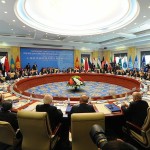Tug-of-War in Central Asia
 As China continues to rise and Russian economic markets unravel, it is clear that the delicate balance of power that has traditionally characterized Sino-Russian relations has begun to shift. While these relations have always been marked by a pragmatic back-and-forth between competition and cooperation, the growing frequency of Chinese incursions into Russia’s “near abroad” have had weighty implications for the economic, political and cultural status quo of lands that have traditionally fallen under Russian influence.
As China continues to rise and Russian economic markets unravel, it is clear that the delicate balance of power that has traditionally characterized Sino-Russian relations has begun to shift. While these relations have always been marked by a pragmatic back-and-forth between competition and cooperation, the growing frequency of Chinese incursions into Russia’s “near abroad” have had weighty implications for the economic, political and cultural status quo of lands that have traditionally fallen under Russian influence.
Nowhere has this great power tug-of-war been felt most keenly than in weak and resource-starved countries in Central Asia such as Kyrgyzstan and Tajikistan. These states have traditionally been dependent on Russian markets for investment and remittances that contribute to the bulk of their GDP and keep their ailing economies afloat. Kyrgyzstan and Tajikistan are both targets for membership in the Russia-led Eurasian Economic Union, which would bind their economies even more intimately to Moscow through the creation of a single economic space.
However, as the ruble has continued its downward course, countries like Kyrgyzstan and Tajikistan have been forced to look for other sources of patronage. China, endowed with an excess of cash and attracted by Central Asia’s markets and natural resources, has been only too happy to fill the void left by a weakening Russia. China is linked to Central Asia through the Shanghai Cooperation Organization (SCO), a platform that promotes interregional cooperation and integration in both security and economic spheres. In May, China unveiled its “Silk Road Economic Belt” plan, which promises $16.3 billion to develop infrastructure that will bolster trade between China and each of the Central Asian states. In addition to trade, China is also taking steps to gain a foothold in the energy sector, and Chinese pipelines to Kazakh oil and Turkmen natural gas have been met with huge success. Investments in Tajik and Kyrgyz gold mining industries have resulted in major outputs as well. These lucrative Chinese business ventures have been mutually profitable, providing Central Asian states with crucial resources to rebuild crumbling infrastructure and gain much-needed investment. Economic relations with China have the added benefit of being refreshingly free of the uncertainty and political manhandling that is common in dealings with Russia, who has earned the reputation of a fickle and undependable patron in recent years. From this perspective, China’s newfound presence in the region is a breath of fresh air and a welcome change from traditional Russian omnipotence.
The optimistic narrative of Chinese investment is not the whole story, however. There are many in Central Asia who view the shift from Russian to Chinese influence as no more than a transfer of the reins of power from one despotic master to another, with this one arguably more alien and suspicious than the last. For example, as a result of heavy Chinese investment, Tajik and Kyrgyz governments are heavily indebted to Chinese banks, thus finding themselves under the same threats to sovereignty that were common under times of Russian hegemony.
The Chinese have also failed to win over local sympathies, to disastrous effect. Unchecked trade with China has left native populations extremely wary of the flood of cheap Chinese goods into local shops and bazaars, the quality of which is often low and/or unregulated. Tensions regarding increased Chinese immigration are also high, as locals complain that new Chinese migrants fail to respect or assimilate to Central Asian lifestyles. These factors have contributed to an atmosphere of hostility and noncompliance among Central Asian citizens towards Chinese incursions into the region. Many bemoan the retreat of Russia, with whom they feel a kinship of shared history and culture. Sebastien Peyrouse of John Hopkins University argues that underlying cultural differences with the Chinese is a major obstacle to achieving closer relations, noting that “China is perceived as being foreign, and even as incompatible, whereas there is still a dominant feeling of proximity and even of intimacy with Russia. Compared to potential Chinese domination… Russia continues to be seen as a lesser evil.”
While it is clear that China is best positioned to take hold of the economic reins in Central Asia, it is nevertheless undeniable that Russia still controls the sympathies of local populations. Caught in the middle of this great power tug-of-war for resources and influence, Central Asia remains a wild card that continues to elude total loyalty or vassalization to any one master. This is itself a great asset, as it provides the states of the region with valuable political leverage. Harnessed effectively, this leverage could allow Central Asian countries to themselves become players, rather than pawns, in the wider great power game that surrounds them.
